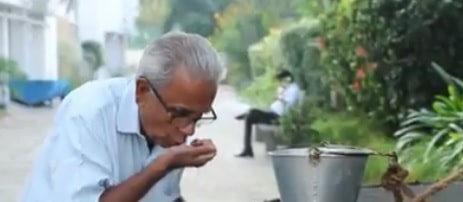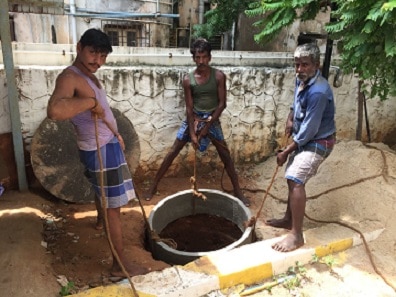Our whole life is disrupted,
Sighed a drought thirsty Chennai in the brutal summer of 2019. The cries of the empty water pots started hitting even the international headlines. The exhausted mass was either queuing up behind the purchased water tanks or waiting for the hourly mercy of tap waters. India was facing one of the lethal most water crises in its history and the southern metropolis with its 11 million inhabitants was undoubtedly the worst sufferer.
It was during this time, that the 71-year-old Messiah, Dr.Sekhar Raghavan, shouldered the responsibility of bringing back the lost life to the city with his meticulous understanding of the simple process of rainwater harvesting (RWH).
The opening years
Rainwater harvesting, as we all know, is the collection and storage of rain, rather than allowing it to run off. Rainwater is collected from a roof-like surface and redirected to a tank, cistern, deep pit, aquifer, or a reservoir with percolation, so that it seeps down and restores the ground water.
Dr. Raghavan, a former Physics professor who had also been a marketing manager, is the pioneer and director of this system in Chennai. Popularly known as the ‘Rain Man’, he has now worked with the process for over two decades.
The journey started in 1995 when Raghavan assembled a group of plumbers and they came up with a design for the pits that would suit Chennai’s soil condition. The man himself started walking from door to door and hovering around the city in a bicycle with the sole aim of educating the mass about the benefits of this super process as he could well understand the scarcity of water Chennai was about to face in the coming years. According to him, the colossal water crisis could easily be averted once the rainwater harvesting systems get installed in every household of the city. But people kept on ignoring his theory.
People thought I was crazy. Even educated people don’t understand that ground water is essentially rainwater that has percolated into the ground.
Dr.Raghavan recalls when asked about his early struggle
The locality was an add-on
Talking about his locality, Raghavan says,
Chennai as we all know is a coastal city with sandy beaches and I have been living for the past 50 years in a place called Besant Nagar. It’s almost 800m from the coastline. The beauty about Besant Nagar is the good ground water it had. In fact the best ground water came from Besant Nagar.
This location was the foremost catalyst that led him to study the rainfall and water systems and deduce that rain water harvesting was the solution to Chennai’s water problems.

Also, coverage in the neighborhood newspapers and support from a school in Besant Nagar that allowed him to talk to parents gave him his first break. However, it took him five years to convince his own apartment building to set up a RWH system.
The Rain Centre
In 2001, a citizen’s group – Akash Ganga Trust, was formed in Chennai to promote, propagate and popularize RWH. Meanwhile, the Tamil Nadu Government made RWH mandatory for every household and non-compliance to this rule resulted in fines or cutting of the government water supply. Raghavan played a pivotal role in implementing this rule in 90% of Chennai’s homes. This helped in maximum preservation of water.
In August 2002, Raghavan started with the Rain Centre in Chennai which was inaugurated by the then Chief Minister of Tamil Nadu. It is one-stop information and an assistance centre for harvesting rain water. The Centre primarily focuses on three objectives:
- To raise awareness of rain water harvesting
- Implementations of rain water harvesting
- Organizing surveys and appraisals

The volunteers of the Centre simplify the process of RWH and play an active role in the installation of the systems throughout the city till date.
Tamil Nadu received less than the average rainfall in the years 2003 and 2004. As a result, the implemented harvesting systems by the Centre did not come into much use. However, 2005 was showered with heavy rainfall and thousands of residents started to appreciate the benefits of harvesting rain water. Speaking about which Raghavan said,
Even then, my studies showed that about 40 per cent of the total buildings actually implemented good quality systems. The benefits of which we can experience today…
After the 2005 rainfall, the ground water levels went up by 20 feet and this was indeed a motivation to pursue their cause.
The boost in 2019
It’d been more than a decade since Raghavan started with his mission of rain water conservation and Chennai again faced an acute water crisis in 2019 as monsoon was a failure in 2018. During that time, the Rain Centre started getting 20 calls each day from residents all over the city seeking for the expert’s advice. He had successfully helped about 500 houses at that time. In an interview with CNN in 2020, he had said,
Last year was the turning point. Before 2019, people did not show so much interest in rain water harvesting because they always thought that rain water harvesting was an option but that is not true. Any house any apartment complex having either an open well or a bore well should harvest rain
After this success in Tamil Nadu, many of the other states started showing interest and visiting the Rain Centre to learn about RWH.
The Modus Operandi
The process roughly includes:
- Identifying the water catchment areas and ensuring the smooth water flow
- Building of recharge wells to store the collected water
- Recharging the wells depending on the area of the housing complex and the amount of rainfall,
- Finally, digging the well a few feet deeper once the sandy layer is reached.
This way, the water gets filtered and recharges the groundwater.

Raghavan explained back in 2019,
I spend nearly three hours every night responding to every e-mail. I have received about 300 messages so far and have visited 100 senders. I am glad that people have finally understood the importance of water harvesting. Each location is grouped area-wise and I visit one locality every day. We can’t depend on the government for everything. Some efforts need to be made by individuals, and I will leave no stone unturned in ensuring sound guidance to those willing.
Besides, Raghavan has also started an ecological sanitization project in Kovalam, on the East Coast side, just outside Chennai.
The much needed alarm
The works of the Rain Man alone has awakened the entire Nation to the brighter side of a dark reality and also alarmed the folks about their irresponsibility when it comes to extensive uses of the city’s resources. We waste liters of water daily, but never really replenish them. Dr.Sekhar Raghavan solved a modern problem with a traditional solution. Today, school and college students also visit him regularly to do projects on water management systems and rainfall.

Thus, Raghavan transformed an illusion into reality after years of perseverance, apparently saving a city in its direst hours. As he always believes,
With passion, you can learn anything…

